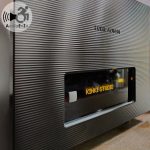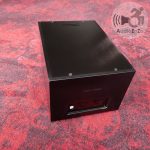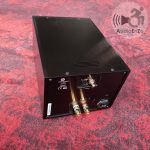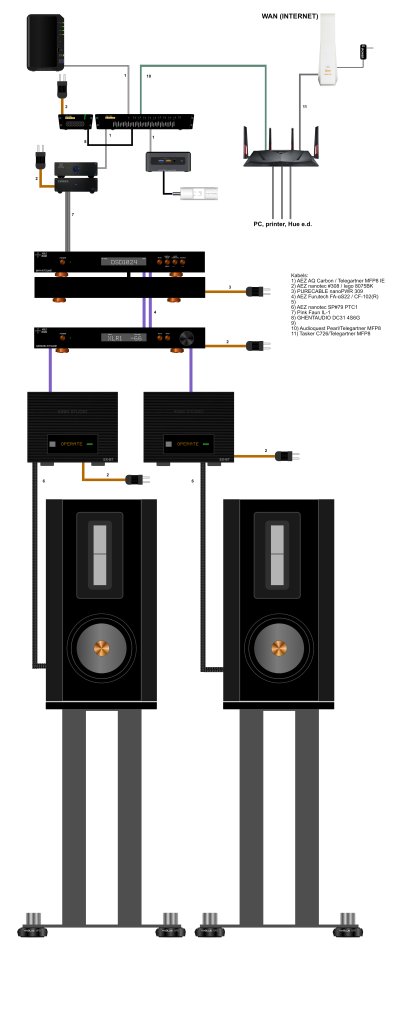
![]() At the end of last year I had the opportunity to listen to the Kinki Studio EX-M1 + . The sound quality that I experienced in my set at that time gripped me to such an extent that I decided to sell the Audio-GD M1 / M3 amplifier. And that wasn’t an easy a decision because these are very good amps and I really enjoyed it.
At the end of last year I had the opportunity to listen to the Kinki Studio EX-M1 + . The sound quality that I experienced in my set at that time gripped me to such an extent that I decided to sell the Audio-GD M1 / M3 amplifier. And that wasn’t an easy a decision because these are very good amps and I really enjoyed it.
I recently got some comment because of the praise I had given about the Kinkis and in itself understandable, because I thought the Audio-GDs were the best thing I had ever heard as i wrote down in a previous writing. So this couldn’t be better, right? But hey , that was with the knowledge i had at that moment and I did not even know about the existence of Kinki Studio.
This is by no means a degradation of Audio-GD, but the sound of Kinki Studio EX-M1 + was a trigger to take a closer look at amplifiers, Kinki or not. So the Audio-GD set has not gotten worse with the arrival of another brand, it is just different and a matter of taste and correct integration into the rest of the set.
I also love a brand like Holo Audio, the MAY DAC has turned out to be a very good DAC. Holo Audio does not have a full audio lineup, for example they do not make power amplifiers. They do have pre-amps in the program, including the Azure and a new pre-amplifier named Serene will be released very soon!
Kinki Studio also has a nice pre-amplifier, the EX-P7 and is also a candidate, if the Holo Audio Serene doesn’t deliver the sound quality i want. There seems to be even an EX-P8 on the horizon.
All in all, a plan was born: I would like to stick with separate pre-amps and power amplifiers and since Holo Audio has no power amplifiers in the program, my interest tended very strongly towards Kinki Studio and the EX-B7 mono-blocks in particular.
After reading all the reviews, YouTube videos and other experiences I was so convinced that those EX-B7 mono-blocks had to be the right choice that I ordered them. Since there were no demo models available, I just bought them blindly from Jack van Boelsz Audio , but given my experience with the EX-M1 + I dared to (but still a bit scary).
Well, what kind of devices are those Kinki Studio EX-B7? As mentioned, these are mono power amplifiers. You would say nothing special, there are many of them, but these amps do have some nice features on board. Just take the power supply, which already consists of 4 transformers, 2 large toroidal transformers and 2 smaller ones. As a result, the amplifier will not get power quickly.
The used parts are of high quality, just take the Vishay capacitors in the power supply (Nagra uses the same), but also the Exicon mosfets (8 pieces per mono-block and also used by Goldmund!), the gold-plated circuit board and so on. through. The housing is also of a beautiful and heavy quality. This, together with the heavy power-supply, ensures a spicy weight of 17 kg each. Together not as heavy as the 40 kg of the Audio-GD Master 3 and each reasonably easy to handle.
In terms of power, they specify 250W at 8 ohms, but given the maximum output of 84VAC and 20A, the amplifier can handle a lot of load. Here in the AudioEnZo house they have an easy job because they only drive mid and high.
On the front you will find a window with the on / standby button, a matrix display with status text and three LEDs for standby, operation and fault. On the back are the speaker terminals, an RCA and XLR input and the necessary power inlet. The overall build quality is very beautiful and exudes class!
 When the EX-B7s arrived, they initially had to be controlled with the Audio-GD Master 1 . That was sol later on, but Magna Hifi was kind enough to lend me a Holo Audio Azure pre-amplifier (speaking of service) and this listening experience has been done with that pre-amp. If all goes well, the Holo Audio Serene will arrive at the end of this month and another quality step can be made!
When the EX-B7s arrived, they initially had to be controlled with the Audio-GD Master 1 . That was sol later on, but Magna Hifi was kind enough to lend me a Holo Audio Azure pre-amplifier (speaking of service) and this listening experience has been done with that pre-amp. If all goes well, the Holo Audio Serene will arrive at the end of this month and another quality step can be made!
It has been fun to experience how combinations of pre and power amplifiers work out. With the combination of Holo Audio Azure with the Audio-GD Master 3, I could hear the Audio-GD characteristics and that is reflected in a slightly more lay-back sound. This was also the case with the Audio-GD Master 1 on the Kinki Studio EX-B7 power amplifiers.
When the Holo Audio Azure was connected to the EX-B7s, the sound changed to a more dynamic sound. At first that was not what I expected and secretly thought back to the EX-M1 + integrated amplifier with melancholy. Had I gone wrong with the blind purchase of these mono’s?
Fortunately, burning in did a lot of good and after a good number of hours / days the sound was already very close to the EX-M1 +. There was only something annoying in the sound in the middle / high that I couldn’t put my finger on where it was coming from. Until I remembered that when connecting the power cables physical did not come out well at the net entrances of the Kinki’s. In order not to have to turn the power cables too much forcefully, because stiff, I turned the plugs in the power strip and voilà, that fit better.
Well, the importance of a correct phase for a device is a known fact, but I had forgotten that for a while. So I took the plunge and went back under and behind the cupboard with my broken body to correct the phase. What happened then I had not expected at all, the harshness had completely disappeared and the sound image was more holographic than I have ever heard in the room, what a difference. I sometimes put differences in sound under a magnifying glass to be able to interpret it properly, well that magnifying glass is not necessary in this case.
The blind choice for these EX-B7s turned out not to be a blunder but a straight hit ?.
Neutrality and musicality were the goals to achieve. Rich tonal quality, vivid sound imaging, details, high resolution and dynamic. The choice of the components, design, and tuning does just that.
It is the Kinki Studio gears’ sound signature.
 The above is the statement they have on the site at Kinki Studio and we have to experience that and that means playing music!
The above is the statement they have on the site at Kinki Studio and we have to experience that and that means playing music!
I can actually be very brief about it, the sound now coming into the room is indeed rich, dynamic, liquid, spatial and there is a nice feeling of speed. Another item to mention is the seamless integration of the HRS80’s active bass.
Actually, all the music that I played during the listening sessions sounds super good, except for a few very bad recordings, if it’s bad it will stay bad.
The tight and stable placement is striking, guitars sounding rock solid between and separate from the speakers and sounds completely natural and dynamic and where this should be beautifully subtle with quiet passages. Good recordings of a saxophone such as that of Hans Dulfer on the album Duo Dulfer Directie sound powerful and very realistic. Especially when, as on this recording, it is supported by the mighty percussion work of Directie.
A cello as an instrument has never done much to me before, but now listening to Andreas Vollenweider’s new album The Pyramidians where Isabel Gehweiler plays the cello, I notice the beautiful sound of this instrument, it almost has something magical and is a special sensation.
Voices are beautifully interpreted without any sharpness, Anette Askvik must of course be played and sounds super smooth and the saxophone sounds super real in the room. Sara K, who could sometimes sound a bit nasal, has almost gotten rid of her cold and sounds a lot clearer.
The demarcation and placement of absolutely everything in the sound image is phenomenal and creates a beautiful 3D image. You no longer listen to the recordings of musicians, no it is the musicians themselves who are tangibly playing music in front of you, a very nice experience.
I can fill pages full of superlatives about the, in my opinion, gained quality in music experience. I don’t do that, but the reader will understand that I am a happy person as a music lover.
My experience with another amplifier in the form of the NAD M33 was unfortunately not what I had hoped for, but I have heard more people with similar experience. For a little more money than what the M33 costs, there is now an amplifier set (and that includes Azure pre-amplifier) which really makes the M33 as an amplifier pale. The M33’s thin mid-range is filled by the EX-B7s with a rich sound and is powerful, and since the mids contains a large portion of the music, there is a big gain in the sound quality.
 The EX-B7 amplifiers are built like a tank and purely for music and nothing else, there are no bells and whistles and I really like that. The ease of rendering, the authority. The music flows, is elastic, almost tangible, very transparent and everything plays at a bizarre high level. You also notice that these amplifiers have a lot of reserves, you never have the idea that they get out of air at all.
The EX-B7 amplifiers are built like a tank and purely for music and nothing else, there are no bells and whistles and I really like that. The ease of rendering, the authority. The music flows, is elastic, almost tangible, very transparent and everything plays at a bizarre high level. You also notice that these amplifiers have a lot of reserves, you never have the idea that they get out of air at all.
When I talk to others about audio equipment, I often notice that there is still some degenerative action about Chinese stuff. For myself, I had already dealt with that prejudice since I was introduced to Audio-GD. This applies in full to Kinki Studio and this company has set itself the goal of introducing their high-end equipment to the widest possible audience. They make it without huge profit margins and the distribution network is also set up in such a way that not much gets stuck along the way. For example, you can purchase a set of EX-B7 mono blocks for € 3495 (in silver € 100 cheaper) in the Netherlands. That seems like a lot of money, but trust me that this is a real bargain given the build and sound quality. If this quality should be designed, build and distributed in western country’s , I dare say that the price could increase about three (3) times.
I am aware that this writing about my experience with these amplifiers is again a true song of praise, but it is my experience and absolutely sincere! I am therefore very curious what a higher class pre-amplifier can add to quality. I hope to experience that soon, but for now it is already enjoying the music that is created by this set!
HOMEPAGE KINKI STUDIO EX-B7
HOMEPAGE BOELSZ AUDIO
Specifications:
- Frequency response: 0-2.5MHz (± 3dB)
- THDN: < 0.05% (-80db)
- S / N ratio:> 110db (0.01Hz-1MHz),> 130db (A-weighted)
- Output power: 250 W RMS (2-8 Ohm)
- Max immediately available power: 400w RMS (8 ohms)
- Max output voltage: 84VAC, 20A
- Slew Rate: 200 V / us (edge speed <300ns)
- AC supply voltage 240VAC, 50Hz
- Energy consumption: 30W at rest, 600W max
Entrances and exits
- Input sensitivity: 1.45Vrms
- Input Impedance: 51kΩ
- Inputs: RCA x 1, XLR x 1
- Speaker output: clamp / 4mm banana
Sizes and weight
- Dimensions: 330D x 230W x 190H
- Weight: 17KG
Equipment used:
Power cables Nanotec # 308 PC-Triple C copper with Iego copper-rhodium plugs (nanoPWR 308)
1 x Purecable nanoPWR 309 (used on the DAC)
Purecable 8-way Nano Block with iFi AC iPurifier
Synology DS212 + NAS
SOtM sNH-10G switch with sCLK-EX on sPS-500 power supply
Intel NUC8i7BEH with iFi DC iPurifier2 in the power supply
Purecable netHQ V2 network cables (3x)
SOtM sMS-200Ultra Neo with sPS-500 power supply
Tubulus Argentus USB V2 cable
Holo Audio MAY DAC Level 2
Holo Audio Azure pre-amplifier
Purecable linkMSTR XLR interlinks
Purecable linkMSTR RCA interlink
Kinki Studio EX-B & mono power amplifiers


